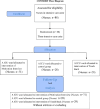Motivational interview and teach back: effectiveness on the rate of hand hygiene compliance in ICU Nurses
- PMID: 39430995
- PMCID: PMC11487744
- DOI: 10.15167/2421-4248/jpmh2024.65.2.2484
Motivational interview and teach back: effectiveness on the rate of hand hygiene compliance in ICU Nurses
Abstract
Introduction: Hand hygiene in nurses is the most effective factor in controlling nosocomial infections. The objective of this study was to assess the effectiveness of motivational interviews and teach-back on the rate of hand hygiene compliance in Intensive Care Unit nurses.
Methods: A quasi-experimental study with pre-test and post-test design was performed. Three Intensive Care Units with 88 nurses were randomly divided into three study groups. The control group received only the usual hospital teaching in hand hygiene, the experimental groups 1 and 2, in addition to the usual teaching, they received motivational interview and teach back in five weekly sessions, respectively. The rate of hand hygiene compliance in nurses was measured by Hand Hygiene Practices Inventory.
Results: There was a statistically significant difference for the rate of hand hygiene compliance before and after the intervention in the study groups with p < 0.001. In comparison before and after, in experimental group 1, the rate of hand rub increased from 8% to 18.5% and the rate of hand wash from 1.5% to 22%; and in the experimental group 2, these values increased from 4% to 19.5% in hand rub and from 3.5% to 17% in hand wash, respectively. However, in the control group, the rate of hand hygiene compliance before and after the test did not show a statistically significant difference with p > 0.05.
Conclusions: Motivational interview and teach back methods were effective in promoting hand hygiene compliance in nurses and thus improve the control of nosocomial infections.
Keywords: Hand Hygiene; Intensive Care Unit; Motivational Interview; Nurses; Teach back.
©2024 Pacini Editore SRL, Pisa, Italy.
Conflict of interest statement
The authors are responsible for the content of this article and state that there is no conflict of interest.
References
-
- Anwar MM, Elareed HR. Improvement of hand hygiene compliance among health care workers in intensive care units. J Prev Med Hyg 2019;60:E31-5. https://doi.org/10.15167/2421-4248/jpmh2019.60.1.918. 10.15167/2421-4248/jpmh2019.60.1.918 - DOI - PMC - PubMed
-
- Boyce JM. Current issues in hand hygiene. Am J Infect Control 2019;47S:A46-52. https://doi.org/10.1016/j.ajic.2019.03.024. 10.1016/j.ajic.2019.03.024 - DOI - PubMed
-
- Sands M, Aunger R. Process evaluation of an acute-care nurse-centred hand hygiene intervention in US hospitals. Eval Rev 2020;41:29 https://doi.org/10.1186/s40985-020-00141-6. 10.1186/s40985-020-00141-6 - DOI - PMC - PubMed
-
- Longtin Y, Sax H, Allegranzi B, Schneider F, Pittet D. Videos in clinical medicine. Hand hygiene. N Engl J Med 2011;364:e24. https://doi.org/10.1056/NEJMvcm0903599. 10.1056/NEJMvcm0903599 - DOI - PubMed
-
- Seferi A, Parginos K, Jean W, Calero C, Fogel J, Modeste S, Scott BA, Daly-Walsh M, Yap W, Kaur M, Brady T, Madaline T. Hand hygiene behavior change: a review and pilot study of an automated hand hygiene reminder system implementation in a public hospital. Antimicrob Steward Healthc Epidemiol 2023;3:e122. https://doi.org/10.1017/ash.2023.195. 10.1017/ash.2023.195 - DOI - PMC - PubMed
Publication types
MeSH terms
LinkOut - more resources
Full Text Sources
Medical

